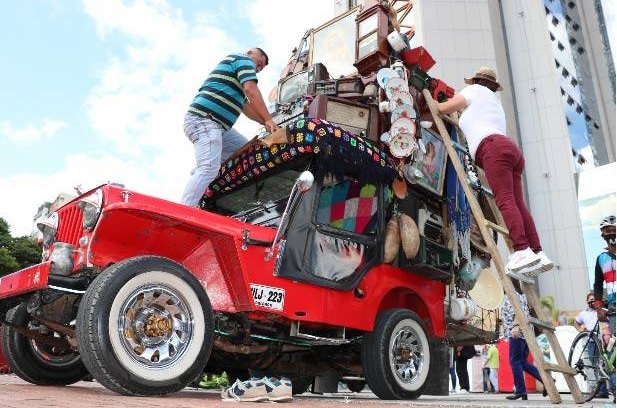| Comentario del autor Víctor
de los Santos Alemañy Eres de los
fuertes, de los que resisten, de los que
laboran, que el tiempo no les afecta ni
disminuye tu producción. Eres
admirable y muchos te aman.
Foto histórica que realza el
patrimonio cultural de Armenia y el
Quindío, Colombia
El Willys MB, es un vehículo
todoterreno de tracción en las cuatro
ruedas, que fue desarrollado y fabricado
por la empresa estadounidense Willys-Overland
Motors. Su diseño no estaba basado en
ninguna otra clase de vehículo, siendo
concebido como respuesta a un
llamamiento realizado en 1941 por el
alto mando militar estadounidense.
La presentación del Willys MB marcó un
hito en la industria automotriz mundial,
al inaugurar un segmento del cual años
más tarde emergió el Willys Jeep,
versión comercial del MB y que con el
paso del tiempo dio forma a un nuevo
concepto de automóvil que fue
precisamente bautizado como jeep.
JEEP: PATRIMONIO CULTURAL DE COLOMBIA
Los jeep Willys llegaron a Colombia en
el 1946, tras finalizar la segunda
guerra mundial.
Por ese entonces la Federación Nacional
de Cafeteros buscaba mejorar la economía
de los caficultores. Una forma de
hacerlo fue la creación de caminos. Los
Willys, al ser capaces de llevar grandes
cargas en toda clase de terrenos, se
volvieron la opción preferida por los
dueños de fincas para transportar sus
productos y a sus trabajadores.
A partir de 1974, con el auge de la
industria del café, los dueños de fincas
comenzaron a cambiar sus Jeeps por
camionetas 4x4 más nuevas, dejando los
Willys para uso exclusivo de los
trabajadores.
La gran calidad de los Willys y su
fuerte chasis, hicieron que estos
todoterreno siguieran en uso. Muchas
personas comenzaron a dedicarse a ser
chofer de Willys, un oficio que dejaba
buenos ingresos en aquella época. Esto
cambió en 1989, con la crisis de la
industria cafetalera, provocando un
enorme descenso en la cantidad de
pasajeros y mercancía que transportaban
los Jeeps.
El Yipao, término usado en Colombia para
referirse a todo actividad con este tipo
de vehículo, fuerte y todo terreno.
Aún así, los Willys siguen en uso hasta
hoy en día, como transporte en el
sector agrícola y turístico,
como cafeterías móviles, como vehículos
de colección y como decoraciones en
tiendas y restaurantes
También se les puede ver cada año en el
Desfile del Yipao, que se realiza desde
1988. En este desfile se puede ver a los
vehículos 4x4 fuertemente cargados con
toda clase objetos (desde costales de
café hasta muebles)
El Gobierno de Colombia espera que el
reconocimiento como patrimonio cultural
ayude a preservar las tradiciones
yiperas y a mejorar las condiciones de
vida de las personas que aún trabajan
con estas camionetas 4x4.

El Desfile Yipao se celebra en
noviembre en la ciudad de Armenia,
Quindío, Colombia, lleno de colorido,
entusiasmo y mucha creatividad.

Commentary by the author
Víctor de los Santos Alemañy
You are one of the strong, of those
who resist, of those who work, that time
does not affect them or decrease your
production. You are admirable and many
love you.
Historical photo that enhances the
cultural heritage of Armenia and Quindío,
Colombia
The Willys MB, is a four-wheel drive
off-road vehicle, which was developed
and manufactured by the American company
Willys-Overland Motors. Its design was
not based on any other class of vehicle,
being conceived in response to a call
made in 1941 by the US military high
command.
The presentation of the Willys MB marked
a milestone in the global automotive
industry, by inaugurating a segment from
which, years later, the Willys Jeep
emerged, a commercial version of the MB,
and which over time gave shape to a new
automobile concept that was precisely
baptized as a jeep.
JEEP: CULTURAL HERITAGE OF COLOMBIA
Willys jeeps arrived in Colombia in
1946, after the end of World War II.
At that time, the National Federation of
Coffee Growers sought to improve the
economy of coffee growers. One way to do
this was to create paths. The Willys,
being able to carry large loads on all
types of terrain, have become the
preferred option for farm owners to
transport their products and their
workers.
Beginning in 1974, with the boom in the
coffee industry, farm owners began
trading in their Jeeps for newer 4x4
trucks, leaving the Willys for the
exclusive use of workers.
The high quality of the Willys and their
strong chassis kept these SUVs in use.
Many people began to dedicate themselves
to being a Willys driver, a job that
left a good income at that time. This
changed in 1989, with the crisis in the
coffee industry, causing a huge drop in
the number of passengers and merchandise
transported by Jeeps.
The Yipao, a term used in
Colombia to refer to any activity with
this type of vehicle, strong and
all-terrain.
Even so, the Willys are still in
use today, as transport in the
agricultural and tourist sector,
as mobile cafeterias, as collection
vehicles and as decorations in shops and
restaurants.
You can also see them every year in the
Yipao Parade, which has been held since
1988. In this parade you can see 4x4
vehicles heavily loaded with all kinds
of objects (from coffee bags to
furniture).
The Government of Colombia hopes that
the recognition as cultural heritage
will help preserve yipera traditions and
improve the living conditions of the
people who still work with these 4x4
trucks.

The Yipao Parade is celebrated in
November in the city of Armenia, Quindío,
Colombia, full of color, enthusiasm and
a lot of creativity.

|